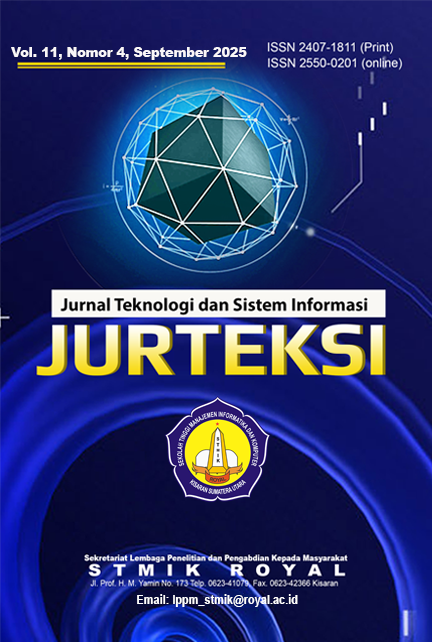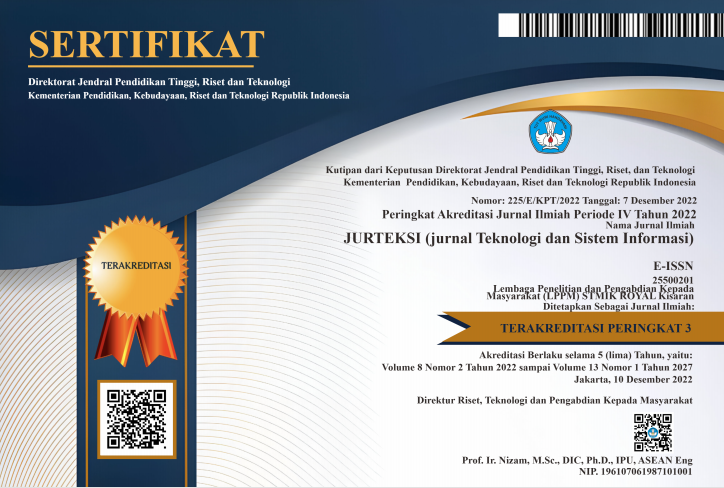CNN-BASED ADAPTIVE IDS WITH FEDERATED LEARNING FOR IOT NETWORK SECURITY
Abstract
Abstract: In the era of the Internet of Things (IoT), cyber threats are increasingly complex and dynamic, thus demanding an adaptive and intelligent network security system. This study proposes a Convolutional Neural Network (CNN)-based Intrusion Detection System (IDS) implemented through a Federated Learning (FL) approach in a Non-Independent and Identically Distributed (Non-IID) data environment. This approach allows the model to be trained in a distributed manner across multiple IoT devices without having to collect sensitive data to a central server, thereby maintaining data privacy while increasing the efficiency of the training process. The experiment used the CIC IoT 2023 dataset, which represents various modern IoT network traffic patterns. The results show that the proposed CNN–FL model achieves an overall accuracy of 0.99, with excellent performance in detecting various types of network traffic. The model obtains a perfect recall value (1.00) for normal traffic (Benign), as well as a very high F1-score for DDoS (0.99) and DoS (0.99) attacks. Stable and consistent performance across all five federation rounds demonstrates that this approach is a reliable, efficient, and accurate solution for detecting threats in distributed and privacy-preserving IoT networks.
Keywords: cnn; federated_learning; ids; non-iid; ciciot2023
Abstrak: Dalam era Internet of Things (IoT), ancaman siber semakin kompleks dan dinamis, sehingga menuntut sistem keamanan jaringan yang adaptif dan cerdas. Penelitian ini mengusulkan Intrusion Detection System (IDS) berbasis Convolutional Neural Network (CNN) yang diterapkan melalui pendekatan Federated Learning (FL) pada lingkungan data yang bersifat Non-Independent and Identically Distributed (Non-IID). Pendekatan ini memungkinkan model dilatih secara terdistribusi di berbagai perangkat IoT tanpa harus mengumpulkan data sensitif ke server pusat, sehingga mampu menjaga privasi data sekaligus meningkatkan efisiensi proses pelatihan. Eksperimen menggunakan dataset CIC IoT 2023, yang merepresentasikan berbagai pola lalu lintas jaringan IoT modern. Hasil penelitian menunjukkan bahwa model CNN–FL yang diusulkan mencapai akurasi keseluruhan sebesar 0.99, dengan performa yang sangat baik dalam mendeteksi berbagai jenis lalu lintas jaringan. Model memperoleh nilai recall sempurna (1.00) untuk lalu lintas normal (Benign), serta nilai F1-score yang sangat tinggi untuk serangan DDoS (0.99) dan DoS (0.99). Kinerja yang stabil dan konsisten di seluruh lima putaran federasi membuktikan bahwa pendekatan ini merupakan solusi yang andal, efisien, dan akurat untuk mendeteksi ancaman pada jaringan IoT yang bersifat terdistribusi dan menjaga privasi (privacy-preserving).
Kata kunci: cnn; federated_learning; ids; non-iid; ciciot2023
References
S. Hirmansyah Siregar, R. Yesputra, P. Studi Sistem Komputer, and S. Royal, “Automatic Security System In Bhayangkara Indah Office From Theft, Gas Leakage, And Fire And Flood Based On Arduino Nano,” J. Tek. Inform., vol. 3, no. 3, pp. 689–695, 2022, [Online]. Available: https://doi.org/10.20884/1.jutif.2022.3.3.261
N. Ariana, S. Mandala, M. F. Hassan, M. Qomaruddin, and B. Ibrahim, “Intrusion Detection System Development on Internet of Things using Ensemble Learning,” vol. 2, 2024.
E. C. P. Neto, S. Dadkhah, R. Ferreira, A. Zohourian, R. Lu, and A. A. Ghorbani, “CICIoT2023: A Real-Time Dataset and Benchmark for Large-Scale Attacks in IoT Environment,” Sensors, vol. 23, no. 13, 2023, doi: 10.3390/s23135941.
J. N. Sibarani, D. R. Sirait, and S. S. Ramadhanti, “Intrusion Detection Systems pada Bot-IoT Dataset Menggunakan Algoritma Machine Learning,” J. Masy. Inform., vol. 14, no. 1, pp. 38–52, 2023, doi: 10.14710/jmasif.14.1.49721.
S. Sahren and L. Adi, Prijuna, “Intrusion Detection System Berbasis Deep Learning Untuk Peningkatan Mitigasi Sql Injection,” vol. 4307, no. 4, pp. 1866–1874, 2024.
S. Mandala, W. Jatmiko, S. Nurmaini, A. Rizal, and Adiwijaya, “OCADN: Improving Accuracy in Multi-class Arrhythmia Detection from ECG Signals with a Hyperparameter-Optimized CNN,” IEEE Access, vol. 13, no. December 2024, pp. 34687–34705, 2025, doi: 10.1109/ACCESS.2025.3544273.
A. Harshavardhan, M. Sree Vani, A. Patil, N. Yamsani, and K. Archana, “Hybrid Deep Learning Framework for Intrusion Detection: Integrating Cnn, Lstm, and Attention Mechanisms To Enhance Cybersecurity,” J. Theor. Appl. Inf. Technol., vol. 103, no. 1, pp. 63–78, 2025.
S. Sahren, R. A. Dalimunthe, H. Saputra, and D. Y. Kurnia Sirni, “Idps Performance Analysis for Mitigating Sql Injections and Syn Flood Attacks,” JURTEKSI (Jurnal Teknol. dan Sist. Informasi), vol. 10, no. 1, pp. 171–178, 2023, doi: 10.33330/jurteksi.v10i1.2880.
Q. Li, Y. Diao, Q. Chen, and B. He, “Federated Learning on Non-IID Data Silos: An Experimental Study,” Proc. - Int. Conf. Data Eng., vol. 2022-May, pp. 965–978, 2022, doi: 10.1109/ICDE53745.2022.00077.
M. R. Wijaya, “Inovasi Model Intrusion Detection System ( IDS ) menggunakan Double Layer Gated Recurrent Unit ( GRU ) dengan Fitur Berbasis Fusion,” vol. 12, no. 1, pp. 10–21, 2025.
Weny Indah Kusumawati and Adisaputra Zidha Noorizki, “Perbandingan Performa Algoritma VGG16 Dan VGG19 Melalui Metode CNN Untuk Klasifikasi Varietas Beras,” J. Comput. Electron. Telecommun., vol. 4, no. 2, 2023, doi: 10.52435/complete.v4i2.387.
M. M. Rashid, S. U. Khan, F. Eusufzai, M. A. Redwan, S. R. Sabuj, and M. Elsharief, “A Federated Learning-Based Approach for Improving Intrusion Detection in Industrial Internet of Things Networks,” Network, vol. 3, no. 1, pp. 158–179, 2023, doi: 10.3390/network3010008.
R. Lazzarini, H. Tianfield, and V. Charissis, “Federated Learning for IoT Intrusion Detection,” AI, vol. 4, no. 3, pp. 509–530, 2023, doi: 10.3390/ai4030028.
B. Li, Y. Wu, J. Song, R. Lu, T. Li, and L. Zhao, “DeepFed: Federated Deep Learning for Intrusion Detection in Industrial Cyber-Physical Systems,” IEEE Trans. Ind. Informatics, vol. 17, no. 8, pp. 5615–5624, 2021, doi: 10.1109/TII.2020.3023430.
J. Li, L. Lyu, X. Liu, X. Zhang, and X. Lyu, “FLEAM: A Federated Learning Empowered Architecture to Mitigate DDoS in Industrial IoT,” IEEE Trans. Ind. Informatics, vol. 18, no. 6, pp. 4059–4068, 2022, doi: 10.1109/TII.2021.3088938.
B. Buyuktanir, Ş. Altinkaya, G. Karatas Baydogmus, and K. Yildiz, “Federated learning in intrusion detection: advancements, applications, and future directions,” Cluster Comput., vol. 28, no. 7, 2025, doi: 10.1007/s10586-025-05325-w.
Y. M. Saputra, G. Alfian, and M. Q. H. Octava, “Perancangan Federated Learning Berbasis Homomorphic Encryption untuk Perangkat Internet of Things,” J. Internet Softw. Eng., vol. 4, no. 1, pp. 1–5, 2023, doi: 10.22146/jise.v4i1.6378.
C. Supriadi, W. Wahyudi, A. Priyadi, and K. S. Jin, “Decentralized AI on The Edge : Implementing Federated Learning for Predictive Maintenance in Industrial IoT Systems,” vol. 4, no. 2, pp. 317–334, 2025.













